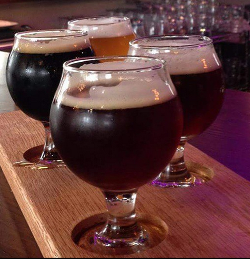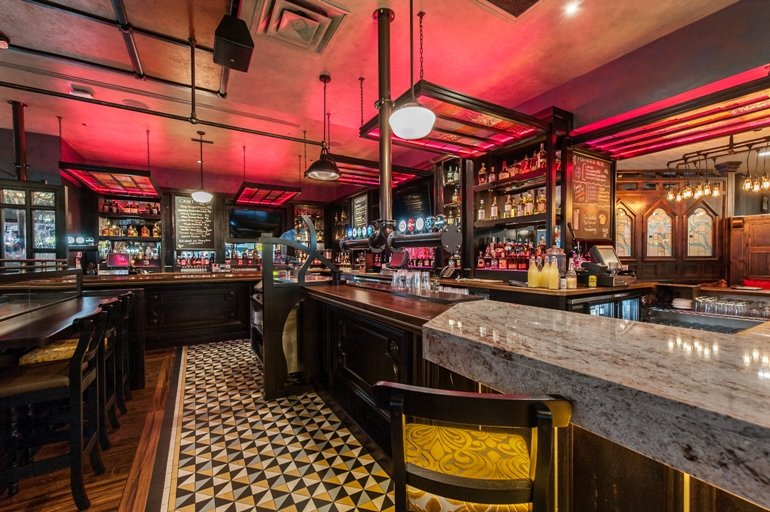Start 14-Day Trial Subscription
*No credit card required

Past and Future Present at Fado Irish Pub
When Kieran McGill opened his first Irish pub in 1996 in the Buckhead Village community of Atlanta, the Summer Olympics hordes were descending on the city, and Guinness and fish and chips were the standard fare.
Nearly 20 years later, McGill is the CEO and President of Fado Irish Pubs, Inc. with 15 pubs stretching from Washington D.C. to Washington state, and menus featuring craft beer and cocktails and plenty of small plate offerings.
The newest Fado opened in Midtown Atlanta on St. Patricks’ Day 2015, hosting Irish Prime Minister Enda Kenny, who was Grand Marshall of Atlanta’s annual St. Patrick’s Day Parade.
But beyond that bit of tradition and a Six Nations Rugby match between Ireland and Wales on the TVs, the bustling urban location portrays a picture of the future – expressing many of the changes happening in Irish pub culture and offering a more international perspective on food and drink.
Not long ago, I sat down with McGill at Fado Midtown, where the soaring windows offer views of the cityscape, the tap handles cascade from the ceiling to the bar, and the draft list includes the likes of St. Bernardus Abt 12, Wild Heaven Invocation and Stone Smoked Porter.
Here’s a good portion of our conversation:
Bob Townsend: The pub scene in Ireland has changed quite a bit, hasn’t it?
Kieran McGill: It’s changed a lot. I think back to when I was growing up. My dad had a pub in Dublin that was called the Maid of Erin. But it was better known as the Confession Box. That was because of its size and the fact that it was located next to St. Mary’s Pro-Cathedral.
In that pub, the only food available was a packet of crisps or a packet of peanuts. And I would say that 80 percent of people coming in drank a pint of Guinness. You roll forward to 2015 and you have quite a number of Irish pubs listed in the Zagat guide and noted for their food and drink. And there are 34 Irish pubs in the 2015 Michelin Eating Out In Pubs Guide.
BT: What’s behind those changes?
KM: Ireland is coming out of a pretty deep recession, and there’s a lot more optimism now. But Ireland has also become a much more international and cosmopolitan place, in terms of how people are eating and drinking. Ireland is still a small island, so there’s a lot of fresh fish, and meat and vegetables. And there’s a greater emphasis on that, while bringing international cooking styles and flavors to those ingredients.
So you now have pubs that are noted for dining as much as for a place to socialize. Going to some of the pubs in Dublin now, you could be in New York or Paris or Milan. They are modern and bright and international, though they still have the Irish hospitality.
BT: How has seeing those kinds of pubs influenced the direction of Fado?
KM: When we opened the first pub in Buckhead in 1996, the idea was to bring an Irish pub to the U.S. more representative of 1996. Roll that forward almost 20 years and the representation of that now is a little different. It’s fascinating for me to go and look at new places in Dublin. In Stephen's Green there are places like 37 Dawson Street and Sams.
I was there with a conference for Irish Pubs Global, which is basically an organization of people who own Irish pubs around the world. They organized a pub tour for people to go and see old Irish pubs, like the Brazen Head. But I didn’t go, because I wanted to see all the new ones. You go to a place like L.Mulligan Grocer in Dublin, which is much more of a gastropub, and it’s all craft beers. They don’t even sell Guinness.
BT: While you’re looking back and rolling forward, what about the design of the Midtown Atlanta Fado, compared to the first pub in Buckhead?
KM: They were both designed by the same person and the same company, Mel McNally of the Irish Pub Company. But our brief to him was we want a pub that’s reflective of modern Ireland. He’s still the foremost designer of Irish pubs around the world. And we said we want to continue to lead the Irish pub segment so we want a pub that’s forward thinking as opposed to retro.
The old pub had sort of low ceilings and fireplaces and snugs. And probably the most noticeable difference was that you had screens on the windows, which made it quite dark, and you couldn’t really see in or out. What you’re seeing here is a much brighter open space that’s more conducive to dining. But also more conducive to people on the outside being able to see in and see how vibrant it is. And what I find fascinating here at nighttime is the light in the street and the street signs and the cars going by. In terms of colors and bright lights, it’s almost like Times Square in New York City. There’s vibrancy on the street that helps create an atmosphere in here. And we got lucky on the design with our patio, which is actually set into the building and makes it much more of an integral part of the pub.
BT: How do you work out those kinds of design concepts?
KM: I was talking earlier about dad’s pub, the Confession Box. Recently, we opened a bar that was an extension of our pub in Miami, that we call the Confession Box. And we did that because we wanted to try some of these more contemporary ideas. Its emphasis is on craft cocktails and craft beers and small plates of food. In many ways, that was an idea center for this pub. So we’ve taken a lot of the best from what we did there and introduced it here.
BT: How has Fado’s food changed over the years?
KM: Again, when we opened in 1996, we had smoked salmon traditionally prepared with brown bread, capers and onions. We didn’t really sell much of it. Now we have our Smoked Salmon Bites, which are cold oak-smoked salmon on crisp boxty, or Irish potato pancake, that’s made sort of like a blini. It still has capers, onions, with horseradish sauce and lemon, so it’s largely the same product. But it’s presented in a very different way, and it sells like crazy.
BT: And the beer program has really changed over the years, with so many more craft beers. Here, you even have the taps suspended from the ceiling.
KM: We always had what we called the copper box on the counter with the handles on it. As good as those are, and as good as they look, they create a barrier between the bartender and the customer. So we wanted something that would leave the bar open and we had this draft system designed for us. And the beer list has changed a lot. We have Belgian beers and American craft beers and high gravity flights on offer now.
BT: You do a bit of whiskey, too, right?
KM: The other piece for us is definitely the emphasis on whiskey. The Irish pub was always considered a good place to drink beer. But like craft beer, there’s a whiskey revolution now, too. It’s the fastest growing category of spirits. And, of course, Irish whiskey fits perfectly into that.
Additional resource:
www.fadoirishpub.com



